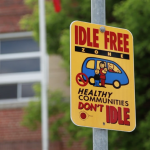 In this section, you will learn about
In this section, you will learn about
- Problems caused by idling
- “Turn Your Key – This School is Idle-Free“ presentations for Grade K-6
![]() Click a topic to jump to a page with details.
Click a topic to jump to a page with details.
Click here to get your “Idle Free Zone” signs.
Here’s our 1-page document: “20 Things you should know about idling“.
Here’s our 3-min video on Idling:
You are idling if you keep your engine on while your vehicle is stationary. Many people idle unnecessarily each day without thinking twice about the impacts.
On average, Canadian motorists idle their vehicles five to ten minutes a day. This time isn’t just in your driveway, but also includes time at red lights, train crossings, and such. Idling wastes fuel, damages engine components, impacts air quality, and contributes to climate change. Idling hits you in the pocketbook, too.
With fuel injected engines, ten seconds of idling burns more fuel than restarting your engine.
Tailpipe emissions include massive amounts of carbon dioxide (CO2) and nitrogen oxides (NOx). The former is responsible for over 60% of the enhanced greenhouse effect, causing climate change. NOx is 200-300 times more effective than CO2 in greenhouse warming and is a major component of smog. See more on our Tailpipe emissions page.
If every driver of a light-duty vehicle in Canada avoided idling for just five minutes, we could prevent more than 6,000 tonnes of CO2 from entering the atmosphere every year.
Why do we idle?
We often idle because we’re waiting. Waiting for friends and family. Waiting for the last car of the train. Waiting for drive-thru service. Waiting for the vehicle to warm up or cool off. We’re not going anywhere, but the engine is still running, generating harmful emissions. Let’s shut it off!
Lead by example
Not idling is a simple way for each of us to make a change. Our lifestyles are having a major impact on the environment. We must reduce our greenhouse gas (GHG) emissions. We can start by changing our attitudes and behaviours now. Each of us produces about approximately 6 tonnes of CO2 a year through unsustainable lifestyle choices.
Here’s some easy changes to make:
- Railway crossings – turn off your car while waiting in line at busy railway crossings.
- The 10-second rule – Ten seconds have ticked by and you still haven’t moved? Shut the engine OFF.
- Spread the word – Whenever you are in anyone’s idling vehicle, dramatically count down from ten as if you are a rocket scientist preparing for lift-off. Yes, they will look at you funny, but they certainly won’t forget to shut down their engine next time they are idling.




